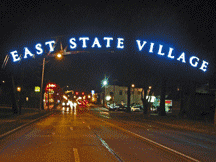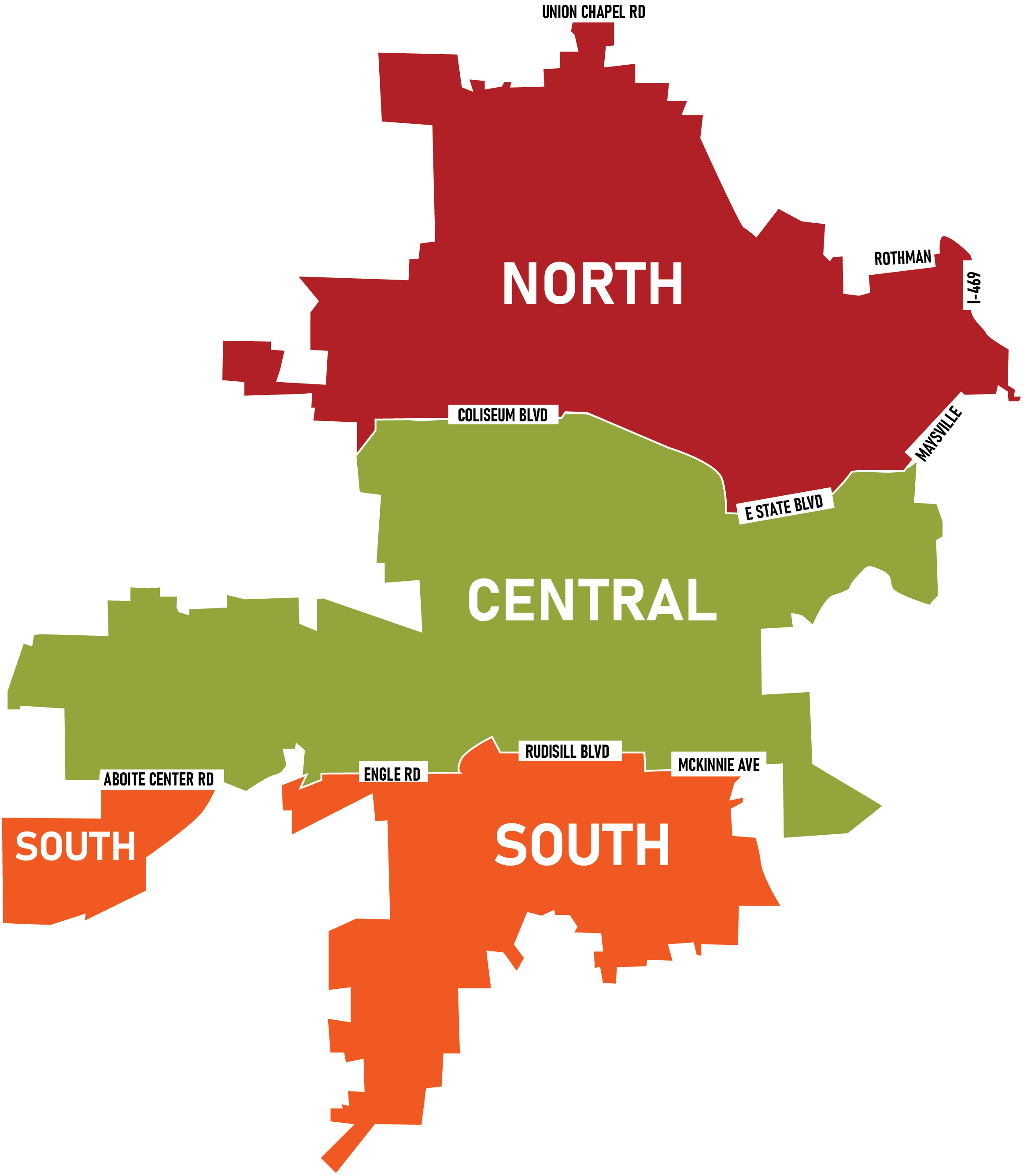WHO WE ARE

The Planning & Policy Department collaborates with other agencies and community stakeholders to develop and implement plans, strategies, and studies.
We provide services in the areas of corridor development, historic preservation, neighborhood planning, transportation planning, mapping, and annexation.
Contact: the Planning and Policy Office:
City of Fort Wayne
200 East Berry Street, Suite 320
Fort Wayne IN 46802
Ph: (260) 427-1140 / Fax: (260) 427-1132
LINKS
DPS - Zoning and Land Use
NIRCC - Regional Transportation
DID - Downtown Improvement
HPC - Historic Preservation
GIS - Maps
APA -American Planning Ass'n
IPA - Indiana Planning Ass'n
CNU - Congress for the New Urbanism
{mooblock=City-County Comprehensive Plan: Plan-it Allen!}
Plan-it Allen! - Our first-ever joint land use and development plan for Allen County and the City of Fort Wayne. The Comprehensive Plan serves as the official policy document for addressing issues relating to growth and development in Allen County, its cities, towns and communities, and the City of Fort Wayne. The Plan provides a framework for future decision making grounded in extensive community involvement and a solid analysis of major changes to the area's natural, man-made and cultural environments, as well as the demographics of the area.
Planyourcommunity.org
{/mooblock}
{mooblock=Transportation Planning}
Planning & Policy works toward making an integrated transportation system that is accessible, safe, efficient, and designed within the context of surrounding land uses. We partner with other transportation agencies to develop ways to enhance movement and connectivity - accommodating a range of transportation choices such as public and para-transist, high-speed rail, pedestrian, bicycle, and vehicular.
Bike Fort Wayne
Walk Fort Wayne
 Bus Fort Wayne
Bus Fort Wayne
Transit Study
Passenger Rail
Jefferson-Washington Corridor
 Anthony Grade Separation Study
Anthony Grade Separation Study  Front Door Fort Wayne PlanNIRCC 2030 Plan
Front Door Fort Wayne PlanNIRCC 2030 Plan
{/mooblock}
{mooblock=Community Development Area Plans (CDAP)}
Community Development Area Plans
The City of Fort Wayne's Housing Strategy recommended that planning be reintroduced at the neighborhood level. To achieve this goal, Planning & Policy partners with neighborhood residents and other community stakeholders to develop implementable and measurable community development plans.
During the planning process, residents, community groups, property owners, and business owners identify and discuss issues, develop goals and create strategies. Plans usually include four basic elements: land use, transportation, housing, and community facilities. Other specific issues identified by community members also can be addressed by the plan.
Benefits of a Plan
Plans are presented to City Council for formal adoption and become a component of the City's Comprehensive Plan. The approved plan is used by City departments, boards, and commissions as a guide for decision-making. Key projects from plans may be selected for inclusion in the Annual Improvement Project Report to City Council as a part of the budget process. Plans also help communities organize their ideas into a single document that can be shared with residents, potential community partners, and investors.
Completed Plans
Bloomingdale / Spy Run Plan
East Central Plan
Memorial Park Plan
Nebraska Neighborhood Plan
Northside Neighborhood Plan
Packard Area Planning Alliance (PAPA) Plan
West Central Plan
{/mooblock}
{mooblock=Commercial Corridor Planning}
Fort Wayne has a dozen commercial corridors located within the central part of the city. These urban corridors are important to the community because of their character, urban development patterns, relationship to the surrounding neighborhood, pedestrian oriented streetscapes, and distinct urban architecture and form. These corridors were historically developed with a mixture of residential and commercial uses and served as the "main street" for many of the city's urban neighborhoods.
Completed Corridor Plans/Projects (each will evantually have a short overview & photos)
South Calhoun
Southeast Industrial Corridor Project
Broadway
East State
North Anthony
Wells Street
Future Corridor Plans/Projects
Fairfield
West Main Street
{/mooblock}
{mooblock=Gateway Strategy}
The Gateway Initiative is a 10-year strategy to enhance Fort Wayne's primary gateways. The goal of this strategy is to develop short-term and long range recommendations to improve the function and aesthetics of existing and future gateways, and to draft policies that will encourage continued maintenance and enhancement of the City's major points of entry. To accomplish this, the strategy will comprehensively review significant gateways leading in and out of the Central Business District, in and out of Fort Wayne (including at interchange areas), and leading from the airport to downtown. Recommendations will identify various gateway elements such as landscape treatments, lighting, pavement design, signage, view sheds, and others.
Gateway Strategy FAQS
 Front Door Fort Wayne Plan
Front Door Fort Wayne Plan
{/mooblock}
{mooblock=Southeast Area Development Strategy}
The Southeast Area Development Strategy is a 10-year vision and planning tool adopted by the City to better coordinate development efforts and to enhance housing and business initiatives in the Southeast area of Fort Wayne.
Southeast Fort Wayne has encountered a slow, steady wave of investment and reinvestment after decades of economic decline. Some new projects have been spurred by the City's own investment of public resources at sites like the Renaissance Pointe housing development and the Southtown Centre commercial location at the former Southtown Mall site. In other cases, private funds were used in new retail construction or rehabilitation of older commercial structures and business centers.
With City incentives provided and business partnerships taking form, it was recognized that a coherent community-based strategy is needed for the Southeast area in order to better focus City resources and maximize the positive impact of new business and housing activity.
Homepage
{/mooblock}
{mooblock=Historic Preservation}
Historic preservation is the practice of protecting and preserving buildings, sites, structures, objects or districts that reflect elements of local, statewide, or national history. Areas of historical significance could include (for example) cultural, social, economic, political, archaeological, or architectural history.
The Planning & Policy Department has two preservation planners that serve as staff for the Fort Wayne Historic Preservation Commission (HPC). In addition to duties to the HPC, the preservation staff assists neighborhood associations, businesses and others in interpreting and implementing approved Neighborhood and Community Development Plans. The staff also has the task of revising and updating adopted plans and reports as well as providing the historic components of other plans prepared by the City.
Link to HPC homepage
{/mooblock}
{mooblock=Annexations}
Overview
 Historical map of city annexations
Historical map of city annexations
Winnsboro Pass Voluntary Annexation April 12, 2012
Sedation Dentistry Voluntary Annexation July 27, 2012
{/mooblock}
{mooblock=Downtown}
Downtown Fort Wayne says much about who and what we are as a community. It marks the place of our beginning. It defines our image. It is the showcase for our creative spirit, our heritage and our pride of place. It is where we gather to celebrate, to affirm our beliefs and to realize our greater civic mission. As times have changed, so has the role of downtown. From Kekionga's trading village to its days as a territorial fortress, from transportation hub to the seat of government, from commercial nexus to the hothouse for art and culture, each era has invented and invigorated Downtown Fort Wayne with a new focus and energy. Planning & Policy continues to partner with the Redevelopment Department and others to provide the framework for transforming downtown into a place to live, work and play.
Design Guidelines
 Downtown Zoning
Downtown Zoning
 Downtown Blueprint
Downtown Blueprint
 Blueprint Plus
Blueprint Plus
DID
{/mooblock}
{mooblock=GIS - Maps/Special Projects}
GIS-Maps / Special Projects provides strategic research to assist in the direction of Division resources, management of special projects and develops/leads implementation of the Division technology strategy. It provides data, analysis, and GIS support to the Division.
GIS homepage
{/mooblock}
 The Fort Wayne Street Department will begin the annual leaf collection on October 30th. There will be two rounds of leaf collection in each of the City's more than 400 neighborhoods.
The Fort Wayne Street Department will begin the annual leaf collection on October 30th. There will be two rounds of leaf collection in each of the City's more than 400 neighborhoods.


